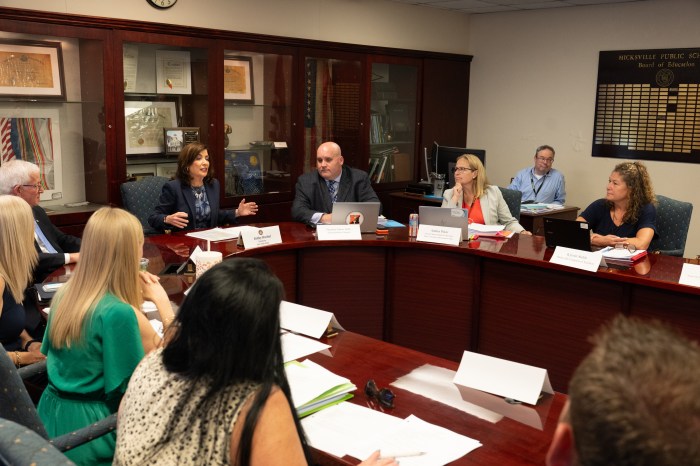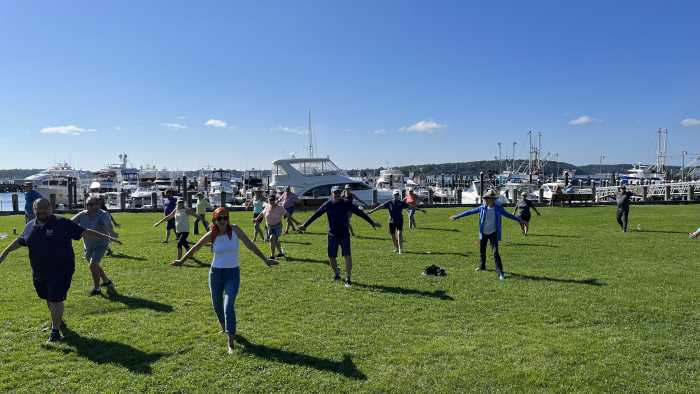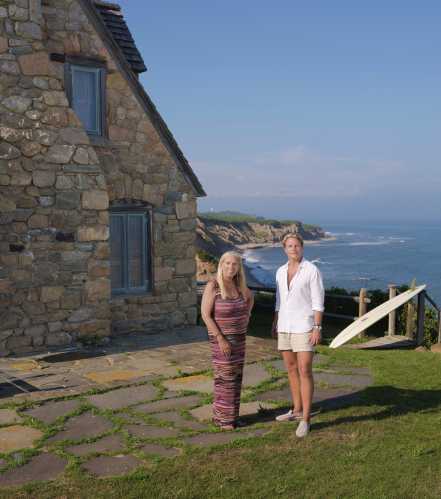Comment period extended to Jan. 11, 2012 to request that Cuomo protect water supply and ban fracking
Governor Cuomo’s proposal to open New York to hydraulic fracturing, or fracking, has come under fire for failing to protect the state’s residents from a method of gas drilling that pollutes the environment, explained a host of speakers at a rally to ban fracking held Dec. 15 at Mary Jane Davis Green in Manhasset.
In this challenging economy the buzzword is job creation and Cuomo has also been criticized for claiming fracking will create jobs, but, as speaker Patti Katz, Reach Out America (ROA), said, “You can’t drink money.” The complaint period against fracking has been extended to Jan. 11, 2012 and rally speakers encouraged everyone to visit amillionfrackingletters.com and to send Governor Cuomo one of their own letters.
A visit to that website explains “hydraulic fracturing or fracking is a means of natural gas extraction employed in deep natural gas well drilling. Once a well is drilled, millions of gallons of water, sand and proprietary chemicals are injected, under high pressure, into a well. The pressure fractures the shale and props open fissures that enable natural gas to flow more freely out of the well.” Additionally it states, “horizontal fracking uses a mixture of 596 chemicals, many of them proprietary, and millions of gallons of water per frack. This water then becomes contaminated and must be cleaned and disposed of.” At the rally it was said Glen Cove is a potential site to store the contaminated wastewater.
Speakers at the rally emphasized many of the same points: studies done to date are inadequate, for example, do not fully explore the negative effect on property values in contaminated areas; and the use of arbitrary assumptions in suggesting the number of jobs that will be created or the amount of gas that will be produced. Nor did the speakers believe adequate studies were conducted on health concerns—Patti Wood explained that since the report, Supplemental Generic Environmental Impact Statement (SGEIS), an 1100 page document, is digitized, one can search key words such as humans, health, asthma or cancer and “there are none.”
The precise cocktail of chemicals used in fracking, the speakers said, is unknown due to what is commonly referred to as the Halliburton Loophole. In 2005, the Bush/ Cheney energy bill exempted natural gas drilling from the Safe Drinking Water Act of 1974 that Congress passed to ensure clean drinking water is free from both natural and manmade contaminates. Because of the loophole, gas companies do not have to disclose the chemicals used during hydraulic fracturing, but, speakers representing breast cancer coalitions said, scientists have identified carcinogens in the wastewater.
Speakers Laura Weinberg and Karen Miller, both representing breast cancer coalitions, cited the environmental risk factors for breast cancer noting scientists have discovered two toxic components of fracking to be benzene and ethylbenzene, known to cause cancer. They claimed no cancer risk analysis was done and that 25 percent of chemicals used in fracking cause cancer.
According to the New York State Department of Environmental Conservation (DEC) Commissioner Joe Martens, the department has been holding a public comment period on its revised draft of the Supplemental Generic Environmental Impact Statement (SGEIS). The department will eventually issue its proposed regulations governing high-volume hydraulic fracturing and the comment period has now been extended to Jan. 11, 2012.
“Throughout this process, DEC’s number one priority is to protect the state’s drinking water and environment in concert with exploring options to safely and efficiently extract the state’s natural gas. This will enable New York’s economy to benefit from this resource and the job opportunities that development is expected to bring,” Martens said.
However, according to speakers at the “Ban Fracking” rally in Manhasset, the jobs are often filled by transient workers hired by gas companies. Nor do New Yorkers benefit from having an available gas source, they said, as the gas, more than likely, will be shipped overseas to capture higher profits.
Patti Wood is executive director of Grassroots Environmental Education, a nonprofit environmental health organization based in Port Washington. She said New Yorkers should demand their rights as citizens and refuse to allow the interests of the few to subjugate the interests of the many and that “threats to our air, our water and a clean food supply are worth fighting for.” She said the citizens of New York State are up against giant, multinational energy industries flush with money.
Wood shared reasons why everyone in Manhasset and on Long Island should oppose fracking—here a few, not already mentioned, she discussed:
1. “Air pollution is a certainty with fracking. Long Island, already identified as a nonattainment area, (air quality does not meet federal standards) sits directly in the air corridor downwind from fracking operations. Diesel tractor-trailers carrying toxic chemicals or radioactive wastewater will crisscross New York State for years. A single fracking well requires one thousand diesel truck trips. Besides the truck traffic, drilling rigs, pumps and generators all run on diesel fuel, and they run 24/7. The total pollution from all phases of fracking will contribute to countless cases of asthma, other respiratory ailments and many cancers that are directly related to exposure to these toxins. The EPA states that there is no safe level of exposure to diesel exhaust.
2. “There is no disposal plan for the millions of gallons of toxic fracking wastewater (or flowback fluid) which contains radioactive elements, brine and other highly toxic chemicals. The DEC’s SGEIS lists wastewater treatment plants here on Long Island for processing these flowback fluids. There is no wastewater treatment plant in NY that can safely and effectively process this waste.
3. “Other states have learned the hard way. Many families in Pennsylvania and other states where fracking occurs have lost their water supplies forever. A similar fate awaits communities in New York State.
4. “Accidents happen. Even with safeguards, the process of fracking is so dangerous that it can never be considered safe. Exxon promised to carefully transport oil through Prudhoe Bay. BP promised that they would drill safely in the Gulf of Mexico. The engineers at the Fukushima nuclear plant promised their safety systems would protect the public. In each case, government regulations were in place to protect us. In each case, they failed.
“Governor Cuomo, and Governor Cuomo alone, will make the decision whether to allow hydrofracking in New York State. He wears a pin on his suit that says ‘I work for the people.’ Let’s hold him to it. If you haven’t written a letter to him, urging him to say no to fracking, please go to amillionfrackingletters.com and write to Governor Cuomo today.
“We can’t un-do fracking. Once it starts, the results are inevitable. Lawsuits will be filed, settlements will be discussed, taxes will go up. Some will profit, but we will all lose something much more precious: our quality of life, our children’s future. This one is worth fighting for.”
In addition to Patti Wood, the speakers were: Assemblywoman Michelle Schimel; Rabbi Lina Zerbarini of the Sid Jacobson JCC; Patty Katz from Reach Out America (ROA); Laura Weinberg of the Great Neck Breast Cancer Coalition; Karen Miller of the Huntington Breast Cancer Action Coalition; Sam Bernhardt, Food and Water Watch and Long Island organizer of the rally; local high school students active in the fight against fracking including the Schreiber Environmental Club and Jason Adasman, junior, Roslyn High School.
Patti Katz, ROA, encouraged those gathered to write letters to Governor Cuomo and Senator Jack Martins, and ask 10 friends to do the same, saying to inform them, “if they vote for fracking we can’t vote for them.” And, Katz added, “fracking is 100 miles away in upstate New York but that isn’t that far away, it’s basically in our backyards.”
The speakers agreed, “There are safer alternatives to producing natural gas; there are no alternatives to water.”


































